A major goal in most zoos is expanding their population through breeding. Along with acquiring animal crates and capturing, breeding is a major way to get more animals.
Breeding
In order to breed, you must have at least one or two animals with a reference that are of the same or compatible species and opposite sexes.
Every breeding can give you between 1 to 4 offspring regardless of species.
Inbreeding within the pedigree is not possible. If an animal shows up more than once, the breeding will be rejected. Any relation that does not show up on the pedigree is allowed with no penalties.
Random chance: A random chance breeding can happen when submitting art to the website. Every roll that your art earns will give you a chance. If the pictured animal has a same-species, opposite-sex counterpart, it will be the animal to breed. If the animal pictured does not have a partner, any pair in the animal's exhibit may breed instead.
Pheromone pills: Pheromone pills, purchasable in the Zoo Shop, allow you to breed 2 compatible animals together. These can be used to breed either 2 of the same species or 2 closely related species (within the same Family)to create hybrid animals. Pheromone pills can be used in Character Pairings to make a litter automatically if the parents are the same species. If they are in the same Family but not the same species (like a lion/tiger or coyote/wolf) it will need to be redeemed on the discord.
IVF Syringe: Don't want to deal with a 2nd parent at all? IVF syringes, purchasable in the Zoo Shop, allows you to breed your animal with an anonymous member of the same species. These are redeemed on the discord.
Contraceptives: Well what if you don't want your animals to breed at all? Thankfully there are now contraceptives, purchasable in the Zoo Shop. These are reversible but will lock your animal from being able to breed entirely. These are added/redeemed on the discord.
Mutations

There is no layering system within mutations. Any can show above or below any other. Albino is the only exception and must show above all else.
Dozer is our model for today! He is a Gray Wolf, and this is what he looks like with no mutations. Below are the mutations and how they all work and combine on a Gray Wolf like him. Though mutations won't look the same on every animal species, Dozer will be a good starting point.
 Albinism: The animal produces no melanin, they are entirely or almost entirely white. Some non-mammals may still have pale yellow markings.
Albinism: The animal produces no melanin, they are entirely or almost entirely white. Some non-mammals may still have pale yellow markings.
 Blue: The animal's pigment is changed into a blue hue. This can range between species but should try to stay within a blue tone.
Blue: The animal's pigment is changed into a blue hue. This can range between species but should try to stay within a blue tone.
 Chocolate: The animal's pigment is changed into a warm brown. This can range between species but should try to stay within a brown tone.
Chocolate: The animal's pigment is changed into a warm brown. This can range between species but should try to stay within a brown tone.



Greying : The animal showes less pigment. It can effect the entire coat and markings or can be in certain spots. The coat can be entirely grey if you chose.
 Melanism: The animal produces much more melanin than usual, resulting in an animal that is entirely or almost entirely black. They can also be a darker brown.
Melanism: The animal produces much more melanin than usual, resulting in an animal that is entirely or almost entirely black. They can also be a darker brown.
 Piebaldism: The animal has white patches over its body while the colored areas remaining the same as a typical coat.
Piebaldism: The animal has white patches over its body while the colored areas remaining the same as a typical coat.
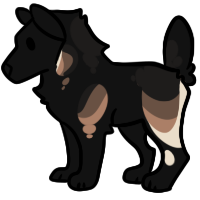 Patches: Spots of black pigment cover the animal in patterns similar to piebaldism. The black pigment is affected by blue and chocolate.
Patches: Spots of black pigment cover the animal in patterns similar to piebaldism. The black pigment is affected by blue and chocolate.
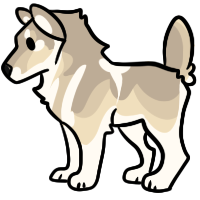
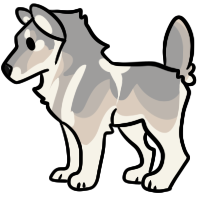
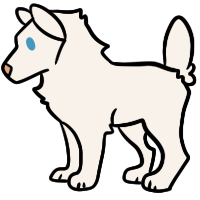
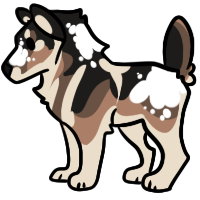
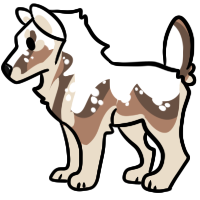
Species-Specific: Species-specific mutations vary depending on what species of animal it presents on. A king cheetah's pattern, a white tiger, or birds retaining their juvenile plumage would all count as species-specific mutations. It could effect color, pattern, or even fur type. If you roll an animal with this, you will need to present it to staff so your specific mutation can be assigned for you.
The wolf below is merely an example of what a wolf could get as a species-specific mutation. From left to right, tanpoint, brindle, and merle.



Combining Mutations
Mutations can add up to some very interesting combinations. You can have one of each mutation, including species-specific.
Blue + Chocolate: Blue and chocolate change the hues of a coat. The colors can vary and can take on a silvery, lilac hue.
 +
+ =
=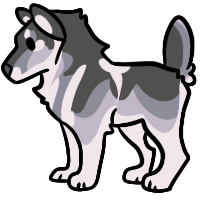
Melanism + blue, chocolate, or both: Melanism creates a layer of black over the coat. Blue and chocolate change the black pigment. This means that the entire coat of the animal will be solid blue, chocolate, or lilac (chocolate+blue). Shown below in order are melanism, melanism+blue, melanism+chocolate, and melanism+blue+chocolate.





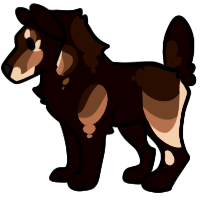
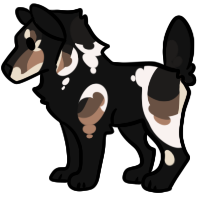
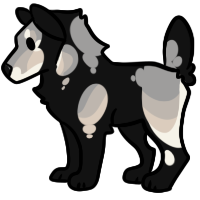
Breeding for Mutations
In general, breeding for mutations is like breeding any other animal. You can use the typical methods: random chance, pheromone pills, or IVF. The inheritance chances are below:
Mutations have a 30% chance of passing. An animal can have more than one mutation, but can only have one of each type of mutation. They can have albino, blue, chocolate, piebald, and a species-specific mutation ect all at one time, but only one species-specific mutation.
Mutation x Normal: 30% pass
Mutation x Same Mutation: 100% pass (if you roll babies from these pairings and they do not have the mutation, let us know here)
Mutation x Different Mutation: 30% pass for each mutation
Hybrids
This group supports purebred animals as well as hybrids. We support both semi-realistic hybrids (realistic like lion/tigers or semi-realistic like fox/wolves) as well as fully unrealistic hybrids, like Horse/Birds. Realistic/semi-realistic hybrids can be gained through normal pheromone pill usage on the discord or random breeding rolls. Unrealistic hybrids can be gained through the use of Specimen Jars.
Each hybrid can have a maximum of 3 named species (for example, Grey Wolf/Red Wolf/Coyote) and any more than that will be called a generic hybrid (for example, Hybrid Canine).
If a hybrid is bred back to a parent species, its offspring have a 50% chance of being a hybrid or a 50% chance of being considered a purebred of that parent species. Littermates can inherit different species. For example, a Grey Wolf/Coyote, if bred to a coyote, could have both purebred coyote offspring AND Grey Wolf/Coyote offspring.
Semi-Realistic Hybrids: These hybrids occur within the same family, and even more often within the same genus. They will usually have a reasonable blend of characteristics between the parent species. Each hybrid can have a maximum of 3 named species (for example, Grey Wolf/Red Wolf/Coyote) and any more than that will be called a generic hybrid (for example, Hybrid Canine).
Unrealistic Hybrids: These hybrids occur between any two species. These hybrids can breed with either parent species or animals closely related to the parent species. A Jaguar/Anaconda could breed to a jaguar, an anaconda, or even a lion. These hybrids can not have additional Specimen Jars used on them to obtain more complex hybrids.